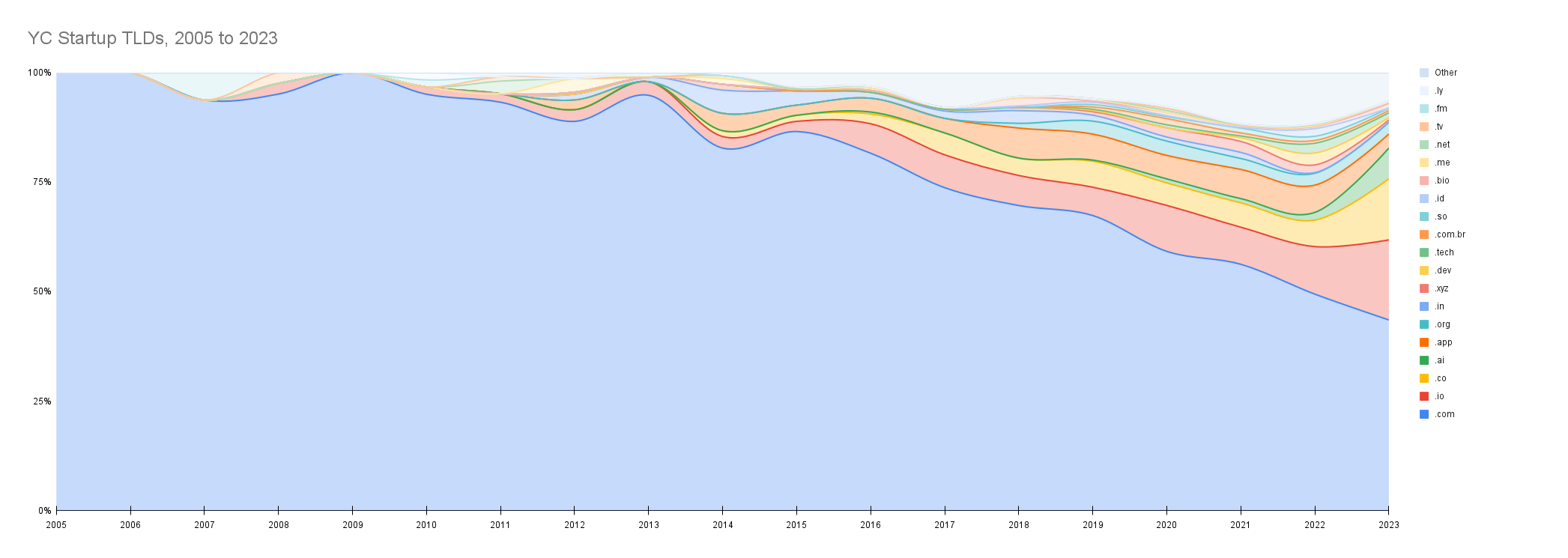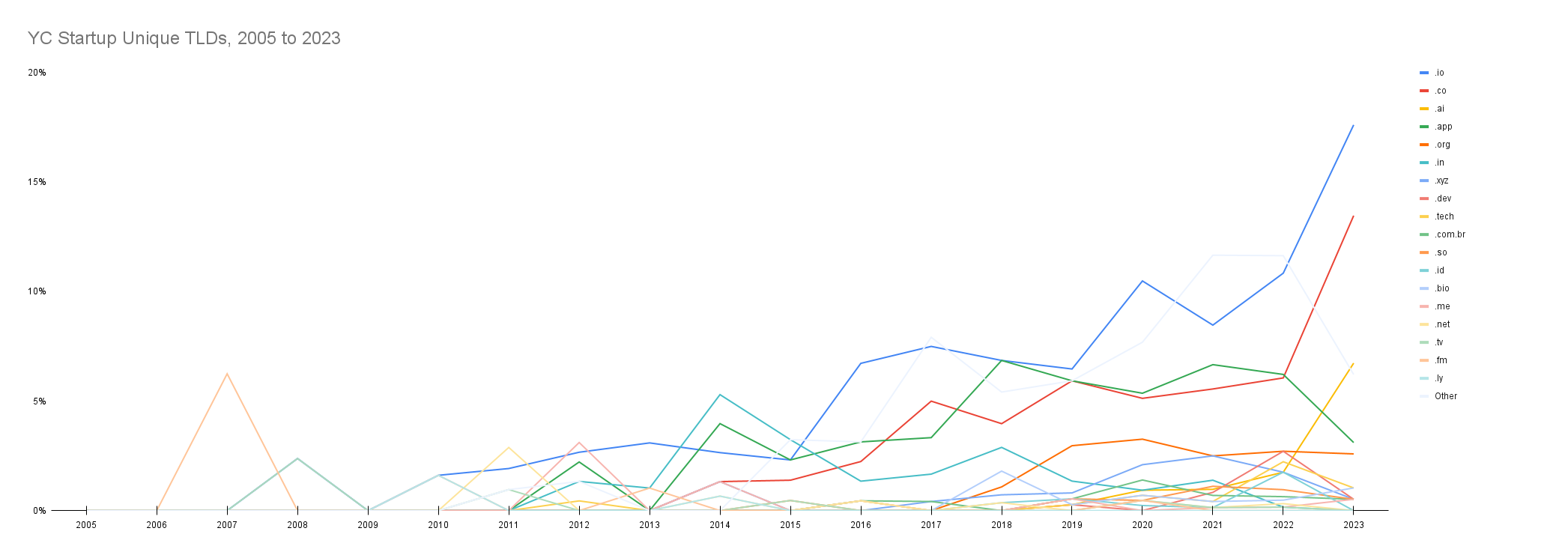
The slow death of dot com: Less than half of startups today use a .com
After decades as the default, dot coms are no longer used by most new startups, and alternative TLDs are the new default.
In the beginning, in the early ’90’s when the internet was young and everything seemed possible, there were only a handful of top-level domains (or TLDs). You weren’t starting a non-profit or government, so .com was the only choice (that, or .net, but you weren’t going to become famous for building a .net, so .com it was). Thus the .com bubble, with the late-90’s phenomena where merely adding .com to your company name could send your stock soaring.
A .com seemingly bestowed legitimacy by virtue of its age and relative scarcity. You’re the real deal once you have your .com, and any domain you bought in the meantime was a stopgap. Or so went the common wisdom.
The valuations and supposed legitimacy came crashing down when the dot com bubble burst, but that wasn’t enough to dent .com’s popularity. As late as 2009, every startup funded by Y Combinator used a .com domain. You never got fired for buying IBM, or a .com domain, it seemed.
That’s changed. Today, only 42% of Y Combinator startups in the winter 2023 batch use a .com domain, while only 40% of the most popular Product Hunt startups used a .com in 2022. Dot com’s have become less obtainable, and alternative TLDs have been around long enough to stick. You don’t need a dot com, anymore.
The Gradual Decline of Dot Com

The cracks in .com’s dominance started slowly. In the YC startup ecosystem, .fm and .io were some of the first newer TLDs to gain a toehold, with .ly showing up in 2010 and .me in 2011. Then the dam broke. 2013 was the last year with over 90% of YC startups using a .com, and the percentage has dropped every year since. By 2022, less than half of new startups used a dot com.
It’s not that .com is going anywhere; it’s still by far the most popular TLD. In the startup world, 2.3x more companies use a .com than .io, the second more popular TLD.
But it’s death by a thousand cuts. It’s not that any one TLD is more popular than .com today, it’s that there are literally 1,589 TLDs to pick from. Why settle for a lengthy, unpronounceable .com when you could get nearly any English word with a dot-something else?
Over the years, YC startups have used 139 different TLDs. Last year, 63 unique TLDs showed up among the 627 new YC startups, including .mba, .design, .space, .homes, .insure, .chat, .finance, .xyz even. As long as it’s safe for work, it’s fair game.
The Fastest Growing TLDs for Startups

But not all of the new TLDs are created equal. A few are most popular among tech startups, enough that using them can put you in a cachet of their own.
.ai’s in the air. From its debut on the YC list, used by 1% of startups in 2014, today 13% of new startups use a .ai domain.
Joining it on the fastest growing TLD list include .io (used by 18% of startups, up from 3% in 2013), .dev (used by 7% today, after its debut on the list with 2% TLD share last year), .bio and .health (each with 1% share). .co was popular for a while, growing from 4% in 2014 to 7% in 2021, but it’s been downhill from there, with only 3% TLD share this year.
And .app, the Google-managed TLD most clearly focused on software startups, is holding steady at 3% TLD share for the fifth year in a row.
How many characters are too many in a domain name?
And that’s not the only change. The folks still going for dot coms have had to change their buying habits to accommodate their relative scarcity. When startups pick a .com today, they’re on average using longer domains than ever.
In 2005, the average Y Combinator startup’s .com had 7 characters. Today, if a startup uses a .com, it has just over 9 characters on average. And the long domains are really long; the longest YC startup’s .com in 2005, clickfacts.com, had 10 characters; the longest in 2022, neuraldynamicstechnologies.com, has twenty-six characters.
Those two startups showcase the best way to still snag a dot com: Use more than one word in your domain name. Someone’s already bought nearly every dictionary word, but put a few together, and you just might find a dot com still available.
That is, if you want one. If over half of today’s best startups skipped a dot com, odds are you could too. Notion liked their notion.so domain so much, they’ve kept it as the default even after acquiring notion.com.
“Alternative endings (TLDs) do not negatively affect your search ranking,” says Google’s official domain advice. If anything, I’ve found that the extra word on the end of your domain can help you rank for those two words together (Reproof.app might rank for “Reproof app”, say, long before it ranks for the single word “reproof”).
The best dot coms may be all taken. The best domains, the ones behind the next billion-dollar companies, are still out there. They just might not be dot coms.
Sources: See the full detailed TLD data in Reproof’s domain research Google Sheets spreadsheet. YC data was obtained via YC Startup Directory and Akshay Bhalotia’s YC Company Scraper; Product Hunt data was obtained from the now-defunct Leaderboard for Product Hunt via Pesto. A 2021 writeup on this data was published on Namecheap’s blog. Header photo by Darwin Bell via Flickr.
